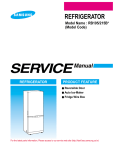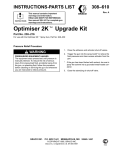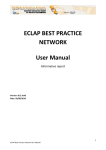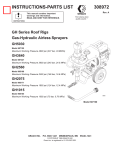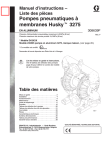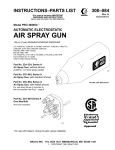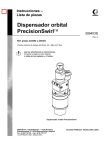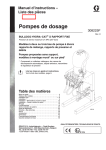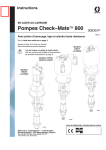Download Graco Inc. 02748 Paint Sprayer User Manual
Transcript
INSTRUCTIONS-PARTS LIST This manual contains important warnings and information. READ AND KEEP FOR REFERENCE. 308–341 Rev. G Supersedes F First choice when quality counts. INSTRUCTIONS Optimiser 2K HVLP Two Component Adhesive Spray Gun 100 psi (7 bar) Maximum Working Fluid and Air Pressure This gun is for use with water-based contact adhesives only Part No. 949–239, Series C U.S. Patent Pending 02748 GRACO INC. P.O. BOX 1441 MINNEAPOLIS, MN COPYRIGHT 1993, GRACO INC. Graco Inc. is registered to I.S. EN ISO 9001 55440–1441 Table of Contents Warnings . . . . . . . . . . . . . . . . . . . . . . . . . . . . . . . . . . . . . . 2 Selection Chart . . . . . . . . . . . . . . . . . . . . . . . . . . . . . . . . 4 Air Flow and Atomizing Pressure . . . . . . . . . . . . . . . . . 5 Installation . . . . . . . . . . . . . . . . . . . . . . . . . . . . . . . . . . . . 6 Setup and Shutdown . . . . . . . . . . . . . . . . . . . . . . . . . . . 7 Ratio Check . . . . . . . . . . . . . . . . . . . . . . . . . . . . . . . . . . 13 Daily Gun Care, Flushing, and Cleaning . . . . . . . . . . 14 Troubleshooting . . . . . . . . . . . . . . . . . . . . . . . . . . . . . . . 17 Service . . . . . . . . . . . . . . . . . . . . . . . . . . . . . . . . . . . . . . 18 Parts . . . . . . . . . . . . . . . . . . . . . . . . . . . . . . . . . . . . . . . . 24 Technical Data . . . . . . . . . . . . . . . . . . . . . . . . . . . . . . . . 26 Dimensions . . . . . . . . . . . . . . . . . . . . . . . . . . . . . . . . . . . 26 Graco Phone Number . . . . . . . . . . . . . . . . . . Back Cover Warranty . . . . . . . . . . . . . . . . . . . . . . . . . . . . . Back Cover Symbols Warning Symbol WARNING This symbol alerts you to the possibility of serious injury or death if you do not follow the instructions. Caution Symbol CAUTION This symbol alerts you to the possibility of damage to or destruction of equipment if you do not follow the instructions. WARNING EQUIPMENT MISUSE HAZARD INSTRUCTIONS Equipment misuse can cause the equipment to rupture, malfunction or start unexpectedly and result in serious injury. This equipment is for professional use only. Read all instruction manuals, tags, and labels before operating the equipment. Use the equipment only for its intended purpose. If you are uncertain about usage, call your Graco distributor. Do not alter or modify this equipment. Use only genuine Graco parts and accessories. Check equipment daily. Repair or replace worn or damaged parts immediately. Use this equipment only in low pressure, air spray systems. Do not exceed the maximum working pressure of the lowest rated system component. This equipment has a 100 psi (7 bar) maximum working fluid and air pressure. Do not lift pressurized equipment. Use fluids or solvents that are compatible with equipment wetted parts. See the Technical Data section of all equipment manuals. Read the fluid and solvent manufacturer’s warnings. Comply with all applicable local, state and national fire, electrical and other safety regulations. WARNING PRESSURIZED EQUIPMENT HAZARD Spray from the gun, hose leaks or ruptured components can splash fluid in the eyes or on the skin and cause serious injury. Do not stop or deflect fluid leaks with your hand, body, glove or rag. Follow the Pressure Relief Procedure on page 7 when: you are instructed to relieve pressure; stop spraying; clean, check or servicing the equipment; and install or clean fluid nozzles. Never point the spray gun at anyone or at any part of the body. Never put hand or fingers over the spray nozzle. Tighten all fluid connections before operating the equipment. Check the hoses, tubes and couplings daily. Replace worn, damaged or loose parts immediately. Permanently coupled hoses cannot be repaired; replace the entire hose. Route hoses away from traffic areas, sharp edges, moving parts and hot surfaces. Do not use the hoses to pull equipment. FIRE AND EXPLOSION HAZARD Poor air ventilation, open flames or sparks can cause a hazardous condition and result in fire or explosion and serious injury. Provide fresh air ventilation to avoid the buildup of flammable fumes from solvent or the fluid being sprayed. Extinguish all open flames or pilot lights in the spray area. Electrically disconnect all equipment in the spray area. Keep the spray area free of debris, including solvent, rags and gasoline. Do not turn on or off any light switch in the spray area while operating or if fumes are present. Do not smoke in the spray area. Do not operate a gasoline engine in the spray area. TOXIC FLUID HAZARD Hazardous fluids or toxic fumes can cause serious injury or death if splashed in the eyes or on the skin, inhaled, or swallowed. Know the specific hazards of the fluid you are using. Read the fluid manufacturer’s warnings. Store hazardous fluid in an approved container. Dispose of hazardous fluid according to all local, state and national guidelines. Dress appropriately for your application. Wear protective eyewear, noise protection for the ears, a personal respirator, gloves and clothing. Selection Chart Includes: Needle/ Nozzle/Air Cap Kit P/N Needle Assembly P/N Air Cap P/N Nozzle P/N Replacement Needle Tip P/N Orifice Size 949–276 238–703 185–794 185–756 191–564 0.020” (0.508 mm) 949–277 238–703 185–794 185–757 191–564 0.026” (0.660 mm) 949–278 238–703 185–794 185–700 191–564 0.030” (0.762 mm) 949–279 238–217 185–794 185–701 191–016 0.042” (1.067 mm) 949–280 238–218 185–794 185–702 191–017 0.055” (1.397 mm) 949–281 238–219 185–795 185–703 191–018 0.070” (1.778 mm) 949–282 238–220 185–796 185–704 191–019 0.086” (2.184 mm) Selecting a Needle/Nozzle/Air Cap Kit The kits range in size to provide different fluid flow rates. Use the fluid nozzle that will give the required flow with the fluid adjustment knob opened four full turns counterclockwise and an adhesive pressure of approximately 5 to 20 psi (0.35 to 1.4 bar). For low flow rates or light viscosity fluid, select the smaller nozzle sizes. For high flow rates or high viscosity fluid, select the larger nozzle sizes. Using an air cap size that is smaller than the nozzle/needle size is not recommended. To help select the proper needle/nozzle size, a fluid pressure gauge may be connected temporarily to the gun fluid inlet to determine the fluid pressure. See Service to install the parts. Selection Problems and Solutions PROBLEM POSSIBLE CAUSE SOLUTION Fluid pressure required to achieve flow rate is too high Using set with too small of an orifice Use needle/ nozzle/air cap set with larger orifice Using a low pressure setting, the fluid flow is too high, making it necessary to restrict needle travel to reduce fluid flow Using set with too large of an orifice Use needle/ nozzle/air cap set with smaller orifice Fluid system will not operate at low enough fluid pressure Fluid regulator is not installed or air regulator is not sensitive enough Add low pressure fluid regulator or add more sensitive air regulator on pressure pot Air Flow and Atomizing Pressure NOTE: All tests completed with the fan air fully open. Atomizing Air Pressure (inlet pressure vs. atomizing pressure) 30 28 26 24 22 20 18 16 14 12 10 8 6 4 2 0 15 20 18 16 14 12 10 8 6 4 2 0 15 NOMINAL ATOMIZING PRESSURE (psi) AIR FLOW (scfm) Air Flow 25 35 45 55 65 75 85 95 GUN AIR INLET PRESSURE (psi) 25 35 45 55 65 75 85 95 GUN AIR INLET PRESSURE (psi) Gun Inlet Pressure Nominal Atomizing Pressure 15 psi (1.05 bar) 1.5 psi (0.11 bar) Air flowing through the gun creates back pressure, which the activator must overcome before beginning to flow. The chart below shows the minimum activator pressure required to overcome the atomizing air pressure. Higher pressures may be necessary to maintain the mix ratio. 25 psi (1.75 bar) 3.0 psi (0.22 bar) 35 psi (2.45 bar) 4.5 psi (0.33 bar) 45 psi (3.15 bar) 6.0 psi (0.42 bar) 55 psi (3.85 bar) 8.5 psi (0.62 bar) 65 psi (4.55 bar)* 10.0 psi (0.70 bar) 75 psi (5.25 bar) 13.0 psi (0.95 bar) 85 psi (5.95 bar) 15.5 psi (1.14 bar) 95 psi (6.97 bar) 18.0 psi (1.32 bar) MINIMUM ACTIVATOR INLET PRESSURE (psi) Atomizing Pressure Versus Activator Inlet Pressure 30 28 26 24 22 20 18 16 14 12 10 8 6 4 2 0 15 * 25 35 45 55 65 75 85 For compliant operation, operate at 65 psi (4.55 bar) or less 95 GUN AIR INLET PRESSURE (psi) 308-341 5 Installation E D G F N A S B R C M J H KEY A B C Optimiser 2K Spray Gun Air Inlet; 1/4 npsm Air Hose Recommend 5/16” (7.9 mm) ID hose; Optional 3/8” (9.5 mm) ID hose D Gun Air Shut-off Valve E Gun Air Regulator F Air Filter G Air Supply Line H Pressure Pot Air Shut-off Valve J Pressure Pot Air Regulator K Activator Pressure Pot L Activator Fluid Shut-off Valve M Activator Fluid Hose N Activator Inlet 1/8–27 npt(f) P Adhesive Pressure Pot Q Adhesive Fluid Shut-off Valve R Adhesive Fluid Hose S Adhesive Inlet; 3/8 npsm (R3/8–19) Q P L K J H 02750 Fig. 1 Fluid Compatibility of Accessories When selecting system components to supply the adhesive and activator, consider the following: Adhesives and activators are water-based and corrosive. Avoid carbon steel, unplated brass, copper, and aluminum. Stainless steel, nickelplated brass and most plastics are usually acceptable. Piston pumps are not recommended for use with adhesives as they are often shear sensitive and will coagulate in your equipment. Stainless steel pressure pots function well in place of a pump and fluid pressure regulator. On drum or tote tank supplied systems, plastic diaphragm pumps are often used. 6 308-341 Some adhesives will coagulate in fluid pressure regulators due to shear. Consult with the fluid supplier for regulator recommendations. Refer to Fig. 1 and see Form No. 305–591 for the accessories recommended to install the system. Consult with the fluid supplier or Graco for specific recommendations. Ventilate the Spray Booth WARNING FLAMMABLE/TOXIC FLUID HAZARD To avoid hazardous concentrations of flammable or toxic fumes, spray only in a properly ventilated spray booth. Comply with all applicable local, state and national fire and safety regulations. Installation Air Line Accessories Fluid Line Accessories The gun air line must have an air regulator (E) to control air pressure to the gun. See Fig. 1. If the gun air source does not have a filter, install a filter (F) on the gun air line to ensure a dry, clean air supply. To eliminate the need to shut off the air pressure at the air supply, install a quick-disconnect at the gun air inlet fitting. If you are using diaphragm pumps to supply adhesive or activator to the gun(s), install a fluid regulator (T) on each gun fluid supply line to control fluid pressure to the gun(s). See Fig. 9, page 9. Install a fluid filter in the gun fluid supply lines to avoid clogging the fluid nozzle. A 100 mesh filter is recommended for the activator supply line to avoid clogging the activator needle and orifice. Use 5/32 or 1/4 inch I.D. tubing for the activator supply line. Setup and Shutdown Pressure Relief Procedure WARNING PRESSURIZED EQUIPMENT HAZARD The equipment stays pressurized until pressure is manually relieved. To reduce the risk of serious injury from pressurized fluid, accidental spray from the gun or splashing fluid, follow this procedure whenever you: Q L 02059 Fig. 2 Are instructed to relieve pressure Stop spraying Check, clean or service any system equipment Install or clean fluid nozzles 1. Close the adhesive and activator shut-off valves (Q and L). See Fig. 2. 02753 2. Trigger the gun into the spray booth* to relieve the fluid pressures and clear excess activator from the gun. See Fig. 3. * Fig. 3 D If the gun has been flushed with solvent, be sure to spray the solvent into a grounded metal waste container. 3. Close the atomizing air shut-off valve (D). See Fig. 4. 02780 Fig. 4 308-341 7 Setup and Shutdown Removing and Installing the Fluid Nozzle Follow this procedure whenever you remove and install a fluid nozzle. See page 4 to select a nozzle or needle/nozzle/air cap kit. 1. Follow the Pressure Relief Procedure on page 7. 3. Trigger the gun while you remove the fluid nozzle (20) with the gun wrench (35). 2 Trigger the gun whenever you tighten or remove the fluid nozzle (20) to pull the needle away from the nozzle seating surface and avoid scratching it. 4. Apply PTFEradhesive to the threads of the fluid nozzle (20) you are installing. 2. Remove the air cap ring (12), air cap (19), and air cap seal (47). See Fig. 5. 1 CAUTION 5. Lubricate the baffle o-ring (17). CAUTION Lubricate the baffle o-ring (17) before installing the fluid nozzle (20). A dry o-ring will prevent the nozzle from tightening properly and adhesive may leak inside the gun. 17 20 35 47 12, 19 6. Trigger the gun while you install the fluid nozzle (20) with the gun wrench (35). Tighten it to 125 to 150 in-lbs (14 to 17 NSm). CAUTION 1 Lightly lubricate baffle o-ring (17) 2 Apply PTFE adhesive to nozzle (20) threads. Trigger gun and tighten to 125–150 in-lbs (14–17 NSm) 02757A Fig. 5 When tightening the fluid nozzle (20), do not exceed 150 in-lbs (17 NSm) torque. Over-tightening can damage the nozzle, affect the spray pattern, and is unnecessary to guarantee a seal. 7. Install the air cap seal (47), air cap ring (12), and air cap (19). Setup and Shutdown WARNING EQUIPMENT MISUSE HAZARD This gun is for use with water-based contact adhesives only. Any other use of the gun could cause unsafe operating conditions or damage to the gun. 2. Flush the adhesive and activator fluid lines with water and blow them out with air before connecting them to the gun. 3. Connect the adhesive fluid hose. A. Connect the fluid hose (R) to the gun adhesive inlet (S). See Fig. 8. 1. Connect the air line. A. Connect the air hose (C) to the gun air inlet (B). See Fig. 6. 1 S R 1 B C 1 1 1/4 npsm 3/8–18 npsm [R 3/8–19] compound thread 02752 Fig. 8 02751 Fig. 6 B. Connect the other end of the air hose (C) to a regulated air supply line (G). See Fig. 7. NOTE: Fig. 7 shows the air supply line filter (F), air regulator (E), and air shut-off valve (D). G F B. Connect the other end of the fluid hose (R) to a regulated fluid supply line (U–see Fig. 9) or a pressure tank (P–see Fig. 1, page 6). NOTE: Fig. 9 shows the fluid supply line regulator (T) and fluid shut-off valves (Q). U E T Q R D Fig. 7 C 01990 02777 Fig. 9 308-341 9 Setup and Shutdown 4. Connect the activator tube. 6. Adjust the spray pattern. WARNING A. Connect the fitting (V) and tube (M) to the gun activator inlet. See Fig. 10. B. Connect the other end of the fluid tube (M) to a regulated fluid supply line or a pressure tank. COMPONENT RUPTURE HAZARD Do not exceed the 100 psi (7 bar) maximum fluid and air pressure of this gun. Higher pressures can cause parts to rupture and result in serious injury. NOTE: Refer to the Atomizing Pressure Versus Activator Inlet Pressure chart on page 5 to help set air and activator pressures. A. Close the fluid adjustment valve by turning the knob (8) fully clockwise. Then turn the knob counterclockwise four full turns to open it. See Fig. 12. V M 8 02784 Fig. 10 5. Position the Air Cap for a vertical or horizontal spray pattern. See Fig. 11. Open 02784 Fig. 12 B. Open the adhesive fluid shut-off valve (Q). Adjust the fluid flow with the fluid regulator (T) installed in the gun fluid line (see Fig. 13) or the air regulator on the adhesive tank (see Fig. 1). Typical industrial flow rates will vary with regulator pressures from 5 to 20 psi (0.35 to 1.4 bar). T Vertical Pattern Q Horizontal Pattern 02020 Fig. 11 Fig. 13 02778 Setup and Shutdown 6. Adjust the spray pattern. (continued) C. Hold the gun parallel to the floor and adjust the adhesive fluid pressure until you have a 1 to 6 inch (25.4 to 152.4 mm) straight fluid stream before the stream falls off. See Fig. 14. D. To further reduce the volume of adhesive output at the gun, turn the fluid adjustment knob (8) clockwise as needed. See Fig. 16. However, for the best results, adjust the adhesive pressure or use a different size needle/nozzle/ air cap combination to change the fluid flow. Refer to page 4. CAUTION Continuously spraying with the fluid adjustment knob closed, will cause accelerated wear on the fluid needle and trigger/air valve shaft interface. 1–6 in. (25.4–152.4 mm) straight fluid stream If the fluid adjustment knob is fully closed, the gun will emit only air and activator. Fig. 14 02754 8 NOTE: A larger fluid nozzle at a reduced adhesive pressure will maintain the same flow rate, but slow down the fluid stream. See Fig. 15. This allows the atomizing air to act on the fluid longer and improve the atomization. Close Fluid Stream of Fluid Nozzles at the Same Flow Rate 02784 Fig. 16 E. Open the pattern adjusting valve by turning the knob (13a) fully counterclockwise. See Fig. 17. 0.042 0.055 0.070 0.086 0.110 (1.067) (1.397) (1.778) (2.184) (2.794) Nozzle Orifice Size in inches (mm) Fig. 15 13a 02755 Close (narrower pattern) Open (wider pattern) 02784 Fig. 17 Setup and Shutdown 6. Adjust the spray pattern. (continued) 7. Adjust the activator fluid flow. F. Set the gun air supply pressure at 40 psi (2.8 bar), using the gun atomizing air regulator (E). See Fig. 18. NOTE: Use the fluid manufacturer recommendations if available and refer to the Atomizing Pressure Versus Activator Inlet Pressure chart on page 5 when adjusting the gun. Local laws may limit the maximum pressure to 10 psi (0.7 bar) at the air cap for HVLP compliance. CAUTION When the activator is being supplied to the gun, the atomizing air must be on before triggering the gun to avoid contaminating the atomizing air with activator. Open the activator supply valve (L) and increase the fluid pressure until the desired amount of activator is sprayed with the adhesive. The typical fluid pressure range is 8 to 20 psi (0.56 to 1.40 bar). See Ratio Check, page 13. E G. Hold the gun about 6 to 8 inches (150 to 200 mm) from the test piece and test the spray pattern and atomization. H. The spray pattern may be too wide with the pattern adjustment knob (13a) fully open. Turn the pattern adjustment knob clockwise until you have the desired pattern size. See Fig. 17, page 11. NOTE: Some pattern air is required to supply the activator; do not close the pattern adjustment knob completely. I. L 01997 Fig. 18 Check the atomization quality again. If necessary, increase the gun air supply pressure with the air regulator (E) in 5 psi (0.35 bar) increments until you have the desired atomization. Fig. 19 02776 8. Shut down the system at the end of the work-shift and before checking, adjusting, cleaning or repairing the system. Follow the Pressure Relief Procedure on page 7. 9. Place the gun nozzle in soapy water over-night to avoid having the tip clog with hardened material. Do not immerse the entire gun. J. If the atomization is still unacceptable, install a larger fluid nozzle size to reduce the fluid stream. Refer to Fig. 15. See page 8 to remove and install a fluid nozzle. K. Repeat steps 6.E to 6.J until you have the desired spray pattern and atomization. NOTE: To eliminate a fan pattern at low atomizing pressures, it may help to remove the activator air restrictor (55). See Fig. 34, page 19. Fig. 20 02785 Ratio Check 521 NOTE: You cannot sample the adhesive and activator at the same time. The adhesive must be checked with the atomizing air off, while the activator must be checked with the atomizing air on. 522 1. Check the ratio of the adhesive. 54 A. Weigh an empty beaker. B. Close the atomizing air shut-off valve. C. Close the activator shut-off valve. D. Trigger the gun into the beaker for 15 seconds to dispense the adhesive. E. Follow the Pressure Relief Procedure on page 7. F. Weigh the adhesive, subtract the weight of the beaker, then multiply the figure by 4 to obtain the weight per minute of the adhesive. 2. Check the ratio of the activator. A. Weigh an empty beaker. B. Cover the beaker with a loose cover to deflect any over-spray. See Fig. 21. C. Disconnect the red tube from the activator valve. D. Connect the ratio check tube (54) (supplied with the gun) to the activator valve outlet fitting (521) as shown in Fig. 21. Turn the front fitting (522) toward the front of the gun. E. Close the adhesive shut-off valve. F. Open the atomizing air shut-off valve. G. Open the activator shut-off valve. 02786A Fig. 21 H. Place the ratio check tube (54) into the beaker as shown in Fig. 21. I. Direct the spray gun into the booth. Trigger the gun for 1 minute to dispense the activator through the tube and into the beaker. J. Follow the Pressure Relief Procedure on page 7. K. Remove the beaker cover. Weigh the activator and subtract the weight of the beaker to obtain the weight per minute of the activator. 3. Adjust the ratio as needed. Adjust the activator supply pressure to change the ratio of adhesive to activator, then check the ratio again. Once the ratio is set, do not change the adhesive or activator supply pressure settings or turn the gun fluid adjustment knob. Any change to the flow of either fluid will change the mix ratio. Daily Gun Care, Flushing, and Cleaning CAUTION Do not point the gun up while cleaning it as this may allow fluid to enter the gun air passages. C. Point the gun down into the spray booth* and spray until the water sprays clear. See Fig. 22. * If the gun is flushed with solvent, be sure to spray the solvent into a grounded metal waste container. Do not use metal tools to clean the air cap holes as this may scratch them and distort the spray pattern. Do not immerse the gun. Squeeze the excess fluid out of the cleaning cloth before wiping the gun. Typically the gun should be flushed or cleaned with soap and water. If solvent is used, do not use methylene chloride with formic or propionic acid as it will damage nylon components. 1. General system maintenance. A. Clean the fluid and air line filters daily. B. Check for fluid leakage from the gun and the fluid hoses. Tighten fittings or replace equipment as needed. 2753 Fig. 22 D. Turn off the fluid supplies. E. Follow the Pressure Relief Procedure on page 7. 3. Clean the gun. A. After relieving pressure, disconnect the activator and adhesive supply lines (M and R) from the gun. See Fig. 23. C. Flush the gun with water if it will not be used in the next three days. Follow the flushing procedure below. M 2. Flush the gun. A. Follow the Pressure Relief Procedure on page 7. B. Disconnect the adhesive and activator supplies and connect the supply lines to a water supply. R Fig. 23 02799 Daily Gun Care, Flushing, and Cleaning 3. Clean the gun. (continued) B. Disconnect the air supply line (C). See Fig. 24. C 02800 Fig. 24 C. Remove the air cap ring (12), air cap (19), air cap seal (47), and fluid nozzle (20) as instructed on page 8. 20 02775A Fig. 26 F. Clean the air cap ring, air cap, and fluid nozzle daily, minimum, using a soft-bristle brush. See Fig. 27. Clean out air cap holes with a soft implement, such as a toothpick, to avoid damaging surfaces. 35 47 12, 19 Fig. 25 02757A D. Soak the air cap ring (12), air cap (19), and fluid nozzle (20) in soapy water. E. Dip a soft-bristle brush into soapy water, point the gun down, and clean the front of the gun. Do not use a wire brush. See Fig. 26. 02011 Fig. 27 308-341 15 Daily Gun Care, Flushing, and Cleaning 3. Clean the gun. (continued) G. Install the fluid nozzle (20) air cap seal (47), air cap ring (12), and air cap (19) as instructed on page 8. Fluid needle shaft Activator nuts, in the area where they contact the trigger Lubricate H. Dampen a soft cloth with soapy water; squeeze out the excess water. Point the gun down and wipe off the outside of it. Lubricate Lubricate 02782A Fig. 28 4. Lubricate the following gun parts daily, using Part No. 111–265 lubricant. See Fig. 29. 16 Pattern adjustment valve threads Fluid adjustment knob threads Trigger pivot pin 308-341 Fig. 29 02756B Troubleshooting PROBLEM CAUSE SOLUTION Fluid flow is fluttering while spraying 1. Fluid nozzle is not tight enough 1. See page 8 to install the fluid nozzle correctly 2. Fluid filter is clogged 2. Check the fluid filter 3. Fluid adjustment knob is not properly set 3. Adjust the fluid adjustment knob for less feathering or use a larger size nozzle 4. Baffle (item 11) is installed wrong or damaged 4. Check if the baffle protrusion is properly inserted into the gun insert hole, see page 19; replace the baffle if damaged 1. Air hose size is too restricted for higher air flows 1. Use larger 3/8 in. ID air hose; order part no. 185–353 2. Fluid pressure is too low 2. Raise the fluid supply pressure or use a smaller fluid nozzle 1. Fluid nozzle is too tight 1. See page 8 to install the fluid nozzle correctly; replace the nozzle if damaged 2. Air cap is too tight 2. Loosen the air cap retaining ring 3. Air cap horn holes are plugged 3. Clean the air cap horn holes with a non-metallic item, such as a toothpick Fluid flow fades while spraying high viscosity fluids Pattern becomes off-set or heavy on ends Fluid system will not operate at low enough fluid pressure [below 10 psi (0.7 bar)] There is no fluid regulator, or the air regulator on the pressure pot is not sensitive enough at low pressures Add a low pressure fluid regulator on the fluid line or add a more sensitive air regulator on the pressure pot. Adhesive residue forms on spray nozzle 1. Activator is dispensing in the atomizing air 1. Do not trigger the gun with the activator on and atomizing air off 2. Activator valve is leaking or not seating properly 2. Clean the needle, seat, and packings; lubricate packings and re-assemble 3. Baffle (item 11) is leaking at baffle protrusion 3. Clean and re-assemble the baffle with a small amount of PTFEpipe sealant on the baffle protrusion or replace the baffle. Make sure that the baffle protrusion is properly inserted into the gun insert hole, see page 19 4. Baffle is leaking at nozzle seal 4. Clean the baffle and replace the nozzle seal 5. Air cap taper is not sealing to nozzle taper 5. Clean and re-tighten the air cap Adhesive collecting in air passages The adhesive nozzle’s internal seal is leaking Clean the nozzle and seat; see page 8 to install the fluid nozzle correctly When the gun is triggered, the adhesive dispenses before the activator or the activator dispenses before the adhesive Activator needle hex nuts are not tight Adjust the activator needle hex nuts until the adhesive and activator needles open together 308-341 17 Service 8. Insert a thin-blade screw driver (A) through the back of the gun and into the packing adjustment nut (31) and remove the screw. See Fig. 31. Items Needed for Service Gun Wrench – provided Seal Installation Tool – provided Adjustable Wrench Screw Driver Part No. 111–265 Lubricant A Soap and water 31 NOTE: Gun Repair Kit 949–285 is available; see page 25. The following procedure covers the replacement of all the kit parts. Disassemble 1. Follow the Pressure Relief Procedure on page 7. Fig. 31 2. Remove the air cap ring (12), air cap (19), air cap seal (47), and fluid nozzle (20) as instructed on page 8. 9. Push the three piece packing assembly (39) out the back of the gun with the threaded end of the fluid needle (21). See Fig. 32. 02762 CAUTION 20 Do not use excessive force to push out the packing assembly (39) or the u-cup seal (33) as this may bend the fluid needle (21). Refer to Fig. 32 and 33. If packings are difficult to remove, use a 3/16 in. plastic rod to push them out. 35 47 12, 19 21 02757A Fig. 30 3. Remove the nozzle seal (17). See Fig. 34. 4. Remove the fluid adjustment knob (8) and spring (16). 5. Pull the fluid needle (21) out the back of the gun. 6. Remove the gun and activator triggers (3 and 48). 7. Remove the fluid adjustment nut (6), spring (15), and air valve (14). 02759 Fig. 32 Service 10. Use the threaded end of the fluid needle (21) to push out the u-cup seal (33). See Fig. 33. 11. Remove and disassemble the activator valve (49). See Fig. 34. Use the threaded end of the activator needle (49d) to push out the needle packings (49g and 49r). Do not bend the end of the needle. 12. Clean the parts. Check the fluid needles (21 and 49d) for damage or excessive wear. Replace if necessary. 21 13. Check the baffle (11) for damage. If it is damaged, carefully pry it off with a screwdriver and replace it. Apply part no. 514–767 Form-A-Gasket Sealant to the front area of the gun where the baffle sits and to the baffle protrusion. Insert the baffle protrusion into the gun insert hole. 14. Lightly lubricate the parts indicated in Fig. 34 with Part No. 111–265 lubricant. 02760 Fig. 33 1 49m 49p 49j 49f 49q 49h 49d 1 49e 49r 49g 49a 53 3 48 49k 49b 49 49c 51 52 55 49e 4 1 2 12 49e 19 1 47 1 5 20 1 17 11 52 33 14 1 21 1 1 4 3 1 39 1 Lightly lubricate 2 Lightly lubricate threads 3 Lightly lubricate contact area on trigger face 4 Apply part no. 514–767 Form-A-Gasket Sealant to the front area of the gun where the baffle sits and to the baffle protrusion. Insert the baffle protrusion into the gun insert hole. Fig. 34 31 1 15 1 8 16 2 32 22 6 05885 308-341 19 Service Assemble NOTE: See Fig. 34, page 19, for the parts that need to be lubricated. A 31 1. Insert the fluid needle (21) through the front of the gun as shown in Fig. 35. Install the new packing assembly (39) by placing them on the end of the needle tip. Orientate the packings as shown in Fig. 35. 02762 Fig. 36 4. Place the new u-cup seal (33) on the seal installation tool (42) with the u-cup lips facing the tool. See Fig. 37. 1 2 5. Push the u-cup seal (33) into the gun until a definite snap is felt. 39 3 CAUTION 21 1 Washer 2 U-cup; lips face down 3 Spreader Apply even pressure to the u-cup seal (33) when installing it to avoid damaging the seal. 33 02763 Fig. 35 1 42 2. Place the packing adjustment nut (31) over the packing assembly and start the threads into the gun, then remove the needle. 3. Insert a thin-blade screw driver (A) through the back of the gun and into the packing adjustment nut (31). See Fig. 36. Do not nick or damage parts with the tool. Turn the screw with the screw driver (about 3 turns); the packing will still be loose. 1 U-cup lips face the tool Fig. 37 02023 Service 6. Slide the new air valve (14) onto the fluid needle (21) until it is against the nut (B). See Fig. 38. 7. Install the fluid needle (21) and air valve (14) into the back of the gun. 9. Remove the u-cup seal (32) from the fluid adjustment nut (6). See Fig. 40. Do not damage the seal surface or the nut’s internal threads. 10. Place the new u-cup seal (32) on the seal installation tool (42) with the u-cup lips facing the tool. See Fig. 40. 11. Push the u-cup seal (32) into the fluid adjustment nut (6) until a definite snap is felt. 21 14 B CAUTION Apply even pressure to the u-cup seal (32) when installing it to avoid damaging the seal. 12. Install the new packing ring (22). 02764 Fig. 38 8. Tighten the packing adjustment nut (31) with the gun wrench (35) until you can feel a slight drag on the fluid needle. See Fig. 39. Do not over-tighten the screw as this may bind the needle movement. 1 U-cup lips face the tool 42 22 32 31 1 35 6 02021 02758 Fig. 39 Fig. 40 Service 13. Install the spring (15) and fluid adjustment nut (6). Tighten the nut to 25 to 35 in-lbs (2.8 to 4.0 Nm). See Fig. 42. 18. Secure the activator valve (49) to the plate (2) with the two screws (53). Tighten the screws to 10 to 15 in-lbs (1.1 to 1.7 Nm). 14. Install the spring (16) and fluid adjustment knob (8). 19. Place the o-ring (49e) in the groove on the plate (2). Lightly lubricate the o-ring, and slide the plate, with the activator valve assembly, onto the top of the gun body. 15. Re-assemble the activator valve assembly. See Fig. 42. a. Make sure the thin end of the needle (49d) is straight to avoid scratching the inside of the nozzle. 20. Install the gun and activator triggers (3 and 48). Tighten the screw (5) to 25 to 35 in-lbs (2.8 to 4.0 Nm). b. Install the o-ring (49g), spreader (49r), and activator packing nut (49h) into the housing (49b), orientated as shown in Fig. 41. Start the packing nut threads, then install the needle (49d). Tighten the packing nut to 20 in-lbs (2.3 Nm). 21. Trigger the gun to test the fluid needle (21) movement. If the fluid needle does not return after the trigger (3) is released or returns slowly, loosen the packing adjustment nut (31) until the needle returns freely. See Fig. 39. Repeat this process to test the activator needle (49d). 22. Adjust the two activator needle hex nuts (49j and 49p) as follows: 49h 49r 1 a. Pull the gun trigger (3) back until you feel resistance against the main fluid needle (21). 49g b. With the activator trigger (48) resting against the gun trigger (3), screw the nuts (49j and 49p) up against the activator trigger. Tighten the two nuts against each other in this position. 49b 1 Spreader taper faces away from o-ring 02781A Fig. 41 c. Assemble the remaining parts. d. Secure the activator housings (49b and 49a) with the four screws (49k). Tighten them evenly to 5 in-lbs (0.6 Nm). CAUTION To avoid damaging the plastic threads, do not overtighten the screws (49k). 16. Install the restrictor (55), flat side up, into the activator outlet housing (49a). 17. Place the o-ring (49e) in the groove in the activator outlet housing (49a). Lightly lubricate the o-ring. c. When properly adjusted, both fluid needles (21 and 49d) will unseat at the same time as you pull back on the trigger. 23. Lubricate and install the fluid nozzle seal (17). 24. Install the fluid nozzle (20), air cap seal (47), air cap ring (12) and air cap (19) as instructed on page 8. 25. Connect the nylon tube (51) between the activator valve outlet elbow (52) and the spray gun elbow (52). 26. Make sure the adhesive packing assembly (39) is sealing by spraying water at low pressure before fully pressurizing the gun. If the fluid packings leak, tighten the packing adjustment nut (31) slightly and retest until the packings seal completely. Service 8 49m 49p 49j 2 49f 49d 49q 49h 49e 49r 49g 49c 49a 53 48 49k 9 49b 49 51 52 9 55 49e 7 2 12 19 49e 47 5 6 1 20 17 11 9 52 33 3 14 21 4 3 39 5 31 1 15 8 16 4 32 22 NOTE: See Fig. 34, page 19, for the parts that need to be lubricated. 1 Tighten to 25–35 in-lbs (2.8–4.0 Nm) 2 Tighten to 10–15 in–lb (1.1–1.7 N.m) 3 U-cup (33) lips face air valve (14) 4 U-cup (32) lips face spring (16) 5 Tighten packing nut as needed for fluid tight seal 1 6 6 Apply PTFE adhesive to nozzle (20) threads. Trigger gun and tighten to 125–150 in-lbs (14–17 Nm) 7 Flat side up 8 Tighten to 20 in-lbs (2.3 Nm) 9 Tighten to 5 in-lbs (0.6 Nm) 05885 Fig. 42 Parts Drawing 49m 49p 49j Ref No. 13 Fan Air Valve Assembly Includes items 13a–13d 49q 49h 49r 49g 49b 49f 49d Ref No. 49 Activator Valve Assembly Includes items 49a–49r 49n 49e 49c 53 49a 49k 48 51 49 52 52 55 12 49e 2 19 47 49e 20 17 11 5 13d 13b 1 25 13c 13a 33 4 21 14 3 39 31 1 15 16 32 22 6 1 35 Tighten to 25–35 in–lb (2.8–4.0 N.m) NOTE: See the Service section for additional assembly information. 8 42 02765A Parts List Part No. 949–239, Series C Optimiser 2K HVLP Spray Gun Ref No. Part No. Description 1 2 3 4 5 238–139 190–247 185–761 625–723 203–953 6 8 11 12 13 188–490 185–745 275–851 276–278 236–006 13a 13b 13c* 13d* 14* 15 16 17* 19l 20l 21l 188–492 188–700 187–699 105–456 236–009 111–291 110–402 103–413 185–794 185–702 238–218 21a 22* 25 31n 32* 33* 35 39* 191–017 188–694 108–382 188–665 110–453 188–493 188–666 236–008 42 47* 48 276–268 625–722 625–725 GUN BODY PLATE, gun TRIGGER, gun PIN, pivot SCREW, lock; No. 10–24 UNC-2A x 0.375” NUT, fluid adjustment KNOB, fluid adjustment BAFFLE, pattern RETAINING RING, air cap FAN AIR VALVE ASSY. Includes items 13a–13d S VALVE, fan air S NUT, air adjustment S O-RING, split; PTFE r S RETAINING RING AIR VALVE ASSY. SPRING, compression SPRING, compression SEAL, fluid nozzle AIR CAP; 0.020–0.055 size FLUID NOZZLE; 0.055 size FLUID NEEDLE; 0.055 size Includes item 21a S NEEDLE TIP; replacement RING PACKING; PTFE PLUG NUT, packing adjustment SEAL, u-cup; UHMWPE SEAL, u-cup; UHMWPE WRENCH, gun PACKING ASSY.; includes u-cup spreader, u-cup seal and packing washer TOOL, seal installation SEAL, air cap TRIGGER, activator valve Qty 1 1 1 1 1 1 1 1 1 1 1 1 1 1 1 1 1 1 1 1 1 1 1 1 1 1 1 1 1 1 1 1 Ref No. Part No. Description 49n 949–217 49a 49b 49c 49dn 49e* 49f* 49g* 49h 49j 49k 625–730 625–729 188–762 949–295 106–555 112–931 103–154 188–665 188–772 113–411 49m 49p 49q 49r* 51* 514–619 112–930 112–929 188–494 187–169 52n 53 54 514–581 514–655 625–779 55* 191–015 ACTIVATOR VALVE ASSY. Includes items 49a–49r S HOUSING, activator outlet S HOUSING, activator inlet S INSERT, nozzle S NEEDLE ASSY., activator valve S O-RING; Vitonr S SPRING, compression S O-RING; ethylene propylene S NUT, packing S NUT, hex S SCREW, cap, SST; 10–24 x 3/4” S NUT, acorn; nylon S NUT, hex S WASHER S SPREADER TUBE; nylon; 5/32 in. (3.97 mm) O.D. CONNECTOR, tube SCREW, cap; 10–32 x 1” TUBE, ratio check; 24” (609.6 mm); not shown RESTRICTOR, orifice Qty 1 1 1 1 1 3 1 1 1 1 4 1 1 1 1 1 4 2 1 1 * These parts are included in Repair Kit 949–285, which may be purchased separately. n Keep these spare parts and the Repair Kit on hand to reduce down time. l See chart on page 4 for other available Needles, Nozzles, and Air Caps. Technical Data Maximum Working Fluid and Air Pressure . . . . . . . . . . . . . . . . . . . . 100 psi (7 bar) Weight . . . . . . . . . . . . . . . . . . . . . . . . . . . 17.5 oz. (0.5 kg) Air Inlet . . . . . . . . . . . . . . . . . . . 1/4–18 npsm (R1/4–19) compound thread Adhesive Inlet . . . . . . . . . . . . . 3/8–18 npsm (R3/8–19) compound thread Activator Inlet . . . . . . . . . . . . . . . . . . . . . . . 1/8–27 npt(f) Wetted Parts Adhesive and Activator . . . 304 and 17–4 Stainless Steel, Acetal, Nylon, Ultra High Molecular Weight Polyethylene Activator Only . . . . . . . . . . . . Buna-N, Nickel-plated Brass, Anodized Nylon (air cap only) Dimensions 6.39 in. (163 mm) 8.0 in. (203 mm) Manual Change Summary Corrected the reference numbers in the parts drawing. Notes The Graco Warranty and Disclaimers Graco warrants all equipment listed in this manual which is manufactured by Graco and bearing its name to be free from defects in material and workmanship on the date of sale by an authorized Graco distributor to the original purchaser for use. With the exception of any special extended or limited warranty published by Graco, Graco will, for a period of twelve months from the date of sale, repair or replace any part of the equipment determined by Graco to be defective. This warranty applies only when the equipment is installed, operated and maintained in accordance with Graco’s written recommendations. This warranty does not cover, and Graco shall not be liable for general wear and tear, or any malfunction, damage or wear caused by faulty installation, misapplication, abrasion, corrosion, inadequate or improper maintenance, negligence, accident, tampering, or substitution of non-Graco component parts. Nor shall Graco be liable for malfunction, damage or wear caused by the incompatibility of Graco equipment with structures, accessories, equipment or materials not supplied by Graco, or the improper design, manufacture, installation, operation or maintenance or structures, accessories, equipment or materials not supplied by Graco. This warranty is conditioned upon the prepaid return of the equipment claimed to be defective to an authorized Graco distributor for verification of the claimed defect. If the claimed defect is verified, Graco will repair or replace free of charge any defective parts. The equipment will be returned to the original purchaser transportation prepaid. If inspection of the equipment does not disclose any defect in material or workmanship, repairs will be made at a reasonable charge, which charges may include the costs of parts, labor, and transportation. Graco’s sole obligation and buyer’s sole remedy for any breach of warranty shall be as set forth above. The buyer agrees that no other remedy (including, but not limited to, incidental or consequential damages for lost profits, lost sales, injury to person or property, or any other incidental or consequential loss) shall be available. Any action for breach of warranty must be brought within two (2) years of the date of sale. GRACO MAKES NO WARRANTY, AND DISCLAIMS ALL IMPLIED WARRANTIES OF MERCHANTABILITY AND FITNESS FOR A PARTICULAR PURPOSE IN CONNECTION WITH ACCESSORIES, EQUIPMENT, MATERIALS OR COMPONENTS SOLD BUT NOT MANUFACTURED BY GRACO. These items sold, but not manufactured by Graco (such as electric motors, gas engines, switches, hose, etc.), are subject to the warranty, if any, of their manufacturer. Graco will provide purchaser with reasonable assistance in making any claim for breach of these warranties. In no event will Graco be liable for indirect, incidental, special or consequential damages resulting from Graco supplying equipment hereunder, or the furnishing, performance, or use of any products or other goods sold hereto, whether due to a breach of contract, breach of warranty, the negligence of Graco, or otherwise. FOR GRACO CANADA CUSTOMERS The parties acknowledge that they have required that the present document, as well as all documents, notices and legal proceedings entered into, given or instituted pursuant hereto or relating directly or indirectly hereto, be drawn up in English. Les parties reconnaissent avoir convenu que la rédaction du présente document sera en Anglais, ainsi que tous documents, avis et procédures judiciaires exécutés, donnés ou intentés à la suite de ou en rapport, directement ou indirectement, avec les procédures concernées. Graco Phone Number TO PLACE AN ORDER, contact your Graco distributor, or call this number to identify the distributor closest to you: 1–800–367–4023 Toll Free All written and visual data contained in this document reflects the latest product information available at the time of publication. Graco reserves the right to make changes at any time without notice. Sales Offices: Minneapolis, Detroit, Los Angeles Foreign Offices: Belgium, Canada, England, Korea, France, Germany, Hong Kong, Japan GRACO INC. P.O. BOX 1441 MINNEAPOLIS, MN 55440–1441 PRINTED IN U.S.A. 308–341 December 1993, Revised April 1997




























